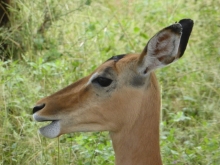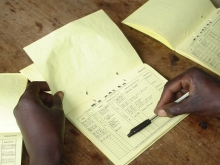The Mudumu Landscape has the highest diversity of large mammals found anywhere in Namibia, as well as a substantial crocodile population. Wildlife here is free-roaming - unrestricted by fences - and can generate a variety of benefits and create an important tourism attraction. Regular and effective monitoring has been recognised as essential for effective management.
Game Patrols
Regular game monitoring patrols are carried out by Community Game Guards and the results are compiled using the Event Book System. This is a structured monitoring system used by many conservancies to monitor wildlife and other resources and create the foundations for adaptive management.
Game Counts
A structured game count is carried out annually in the dry season (September) to assess population sizes, distributions and status. This includes the national parks and conservancies. Game counts were initiated in 2005. For the purposes of the count, the count area is divided into game count zones, each with its own standardised routes. There are currently 4 game count zones in the Mudumu Landscape:
-
Bwabwata East
-
Kwandu-Mayuni-Mashi-Sobbe
-
Mudumu
-
Balyerwa-Dzoti-Wuparo
Methodology
The basic survey methodology used is a series of walked transects which are analysed using a combination of the Distance and the Strip-Count census techniques. In layman’s terms, these can be explained as follows:
Distance
All animals are counted and the distance to each animal, or group of animals, is recorded at right angles to the transect. This distance allows us to apply a species' correction factor for each type of animal counted. This is done in order to compensate for animals not seen. For example, the chances of seeing large animals like zebra over a great distance are much higher than the probability or chances of seeing a smaller animal like a steenbok. Therefore a correction factor of 1.2 can be used for zebra (because one is likely to see most of them over a set distance). A much higher correction factor of 10 can be used for steenbok – over the same set distance one is likely to see only a few steenbok while the rest will be hidden by "dead" ground or obstacles.
Strip-count
All animals are counted and the distance to each is recorded, at right angles to the transect. A strip-width is then determined so that the area covered can then be multiplied into the overall area. This is known as an area correction factor (the number of times a 1,000m wide strip will fit into the whole area). Only the animals inside the 1,000m area (500m on either side of the road) are multiplied by the correction factor, in order to determine the population estimate for the given area.
Species and Biomass
The species for which data are included on this website, and the biomass values used, are as follows:
|
Species |
Biomass (kg) |
|
Buffalo |
500 |
|
Duiker |
19 |
|
Elephant |
4,000 |
|
Giraffe |
830 |
|
Impala |
50 |
|
Kudu |
200 |
|
Lechwe |
70 |
|
Reedbuck |
70 |
|
Roan |
250 |
|
Sable |
210 |
|
Steenbok |
11 |
|
Tsessebe |
125 |
|
Warthog |
70 |
|
Wildebeest |
180 |
|
Zebra |
275 |
Results
Use the lists to view maps, charts and tables of game count results for selected species and years. For a full discussion of the methodolgy and results see the game count reports under
Literature.





